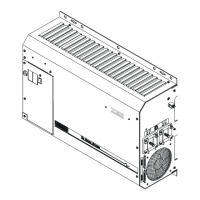INSTALLATION
Copyright Trace Engineering Company, Inc.
5916 - 195th Street N.E.
Arlington, WA 98223
Telephone: 360/435-8826
Fax: 360/435-2229
www.traceengineering.com
PS Series Inverter/Charger
Part No. 3597
Rev. D: November 23, 1999
Page
17
INSTALLATION
This section is very important, since it tells you how to properly install your PS Series Inverter/Charger. It
becomes very frustrating when your inverter system does not perform properly, simply because care was
not taken during installation. Please read this entire section carefully. You will save time and avoid
common mistakes.
This section also describes the requirements and recommendations for installing the PS Series
Inverter/Charger. In the U.S., the National Electrical Code (NEC) defines the standards for both the AC
and DC wiring in residential and commercial applications. It will list the requirement for wire sizes,
overcurrent protection and installation methods and requirements. There are still many other variables not
covered by the NEC. Most are determined by the level of automatic operation, the amount of external AC
and DC power to be controlled and the loads to be operated.
The NEC standards and regulations are described here in general for your convenience, and are not
represented as comprehensive or complete. For comprehensive and complete official standards and
regulations, write the addresses listed below:
NFPA - National Fire Protection Association
National Electrical Code Handbook
1 Batterymarch Park,
PO Box 9101
Quincy, MA 02269-9101
617-770-3000.
Before beginning the installation of the PS Series Inverter/Charger, read all instructions. Disconnect all
sources of AC and DC power to prevent accidental shock. Disable and secure all AC and DC disconnect
devices and automatic generator starting devices.
All installations should meet local codes and standards and be performed by qualified personnel
such as a licensed electrician. Although the DC electrical system may be “low voltage”, significant
hazards may be present, particularly from short circuits of the battery system. Inverter systems by their
nature involve power from multiple sources (inverter, generator, utility, batteries, solar arrays etc.) that
add hazards and complexity that can be very challenging.
After you have finished installing your unit, continue with the FUNCTIONAL TEST section on page 27. This
functional test should be completed prior to configuring your unit’s Menu System for your specific operation.
LOCATION
Inverters are sophisticated electronic devices and should be treated accordingly. Treat the inverter as you
would any fine piece of electronic equipment. When selecting the location to install the inverter, don't think of
it in the same terms as the other interfacing equipment, e.g. batteries, diesel generators, motor generators,
washing machines etc. This is a highly complex microprocessor controlled device. There are nearly 500,000
silicon junctions in its output devices and integrated circuits. The crystal oscillator runs at 4 megahertz. The
drive circuitry timing is accurate to a thousandth of a second. Genetically speaking, it is a cousin to stereo
equipment, television sets or computers. The use of conformal-coated circuit boards, plated copper bus
bars, powder coated metal components, and stainless steel fasteners improves tolerance to hostile
environments. However, in a corrosive or condensing environment (one in which humidity and/or
temperature change cause water to form on components) all the ingredients for electrolysis are present -
water, electricity and metals. In a corrosive or condensing environment, the life expectancy of the
inverter is indeterminate and the warranty is voided if corrosion is the cause of failure.
Caution: It is in your best interests to install the inverter in a dry, protected location away from sources of
fluctuating or extreme temperatures and moisture. Exposure to saltwater is particularly destructive and
potentially hazardous.
Locate the inverter as close to the batteries as possible in order to keep the battery cable length short.
However, do not locate the inverter above the batteries or in the same compartment as vented batteries.
Batteries generate hydrogen sulfide gas, which is very corrosive to electronic equipment and everything
else. They also generate hydrogen and oxygen. If accumulated, an arc caused by the connecting of
battery cables or the switching of a relay could ignite this mixture. Mounting the inverter in a ventilated
enclosure with sealed batteries is acceptable.

